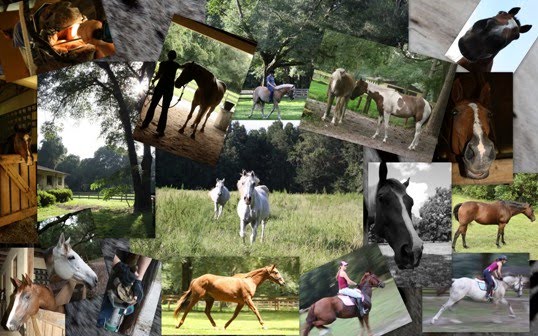** This post has been in draft-form for 2 weeks! And you might be interested to hear that I typed this up before having an issue with a bale of contaminated alfalfa hay. Hmmm!
"Poisonous plants" is a scary topic, but I hope to dispel your fears with a little education.
The questions that come to mind are:
1) How likely is it for my horse to get sick from poisonous plants?
2) How much does he have to eat to become ill?
3) How will I know he's been poisoned?
4) What do the poisonous plants look like?
Fortunately for us, small, private boarding facilities generally don't have a problem with poisonous plants when there is good management. You see most poisonings from horses eating hay that has been baled from a pasture full of these weeds or from horses eating the clippings of a freshly mowed pasture. Most poisonous weeds are thorny, smelly, and simply unappetizing, but that doesn't stop some horses from behaving quite opposite to their ancestors and feral counterparts.
So how likely is it for my horse to get sick from poisonous plants? Well, to all you number-nerds, I don't have the statistics, but it is a rare occurrence that a horse will consume enough of the poisonous plant in our pasture setting to get sick. The few poisonous weeds that we see commonly in our area are just not appealing to the equine pallet in the form of a live, growing weed. If they were dried and shredded and stuck in your horse's flake of coastal then you would definitely have need to worry! But have no fear, I know the weed management protocols of our hay grower and he does an excellent job of keeping weeds from his pastures.
Let's say your horse get bored, curious, or thoughtlessly consumes a poisonous weed. How much does she have to eat to become ill? The answer to this question varies from plant to plant, depending on toxicity. The part of the plant that contains the toxin also varies. Leaves, stem, berries, roots... But no matter which plant he's consumed, the treatment is very similar - supportive care in the form of fluids and alternatively, herbal remedies to detoxify.
So far we know that is it very unlikely for a horse to eat the unappetizing weeds, and even when curiosity overrides instinct the horse has to eat more than just a few bored nibbles. So when is it a real concern?
Well, when it's in the hay (or, in the case of our recent issue, when it's come into contact with the hay), or when there are fresh, shredded clippings after mowing.
Again, have no fear! I do not mow over the poisonous weeds for this very reason. Call me crazy, but I actually pull up and toss (into the woods) the poisonous weeds. We have so few that this is feasible.
And how will you know if your horse has been poisoned? Mainly gastrointestinal signs such as diarrhea, but also fever, lethargy, laminitis. In the case of our contaminated alfalfa, horses had swollen lips and tongue. This was a result of a plant like stinging nettles, one that causes contact dermatitis. A little bute as per our veterinarian and everyone was fine.
And last, but certainly not least, on the list of common questions is "What do they look like?"
I thought it would be helpful to document in picture form all the poisonous weeds on our farm. So here they are:
Pigweed:











Bodhi loves stinging nettle. I think he is one of the dumb ones
ReplyDeleteThank you so much for the post. Great information!